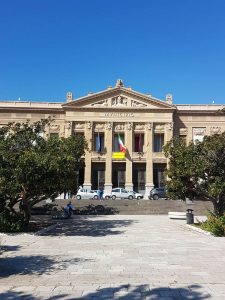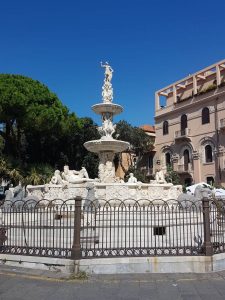
There are many events that invite visitors to discover the beauty hidden in every corner of Messina. During some weekends in September, for example, Le vie dei tesori (The treasure trails) took place. Each point of interest was presented as a precious gem, taken from the ancient and rich of history city of the Strait. On this occasion, different organisations were involved in presenting the most beautiful places of Messina in various ways. The Aura association, for example, offered thematic walks through the streets of the center.
One of these was Sulle orme del mito (on the trail of myth) that began in piazza dell’Unità, in front of the fountain of Neptune. It seems that in ancient times three temples dedicated to the god of the sea were built, but now they no longer exist. The first one seems to have been in the centre, where today the Church of the Annunciation of the Catalans is located, the second one on the top of Mount Dinnamare and the third one, further north, in the area of Capo Peloro.
Commissioned by the Senate of Messina, the fountain was completed in 1557 by the Tuscan sculptor Giovan Angelo Mortorsoli, a follower of Michelangelo. The fountain is situated on three steps, on which a large tank stands. At the top it is possible to see Neptune, who grasps the characteristic trident and stretches his right hand in front of him. On the sides of the divinity, chained, there are the monsters Scilla and Cariddi, from whose faces one perceives the suffering they are experiencing. Along the sides of the tank you can read the inscriptions of the erudite Francesco Maurolico, whose tomb is in the church of San Giovanni Malta, Montorsoli’s signature and the names of the members of Senate.

The fountain was initially on the sea front, outside the city walls, near the port, with Neptune looking at the city as if rising from the water, laying his hand on it. After the seaquake of 1908, the statue was turned towards the sea with Neptune’s hand stretched out on the waters of the Strait as if it were to appease them.
Today, the original statue of Neptune is preserved at the ‘Maria Accascina’ Interdisciplinary Museum along with that of Scilla, while in the center of the square you can admire copies made by Sicilian sculptors Gregorio Zappalà and Letterio Subba.
The walk in search of other myths brought visitors in front of the theatre Teatro Vittorio Emanuele II, whose prospect is dominated by the sculptural group Il Tempo che scopre la Verità e Messina of 1852 by Saro Zagari. The Truth, on the right of Kronos (god of time), holds a torch that illuminates the street, while on the left we find a woman, the personification of Messina, crowned by a walled city and its doors.
Another mythical representation can be found in the tympanum of the Municipal Palace in piazza Unione Europea: the beautiful and proud Regina del Peloro between two sea monsters. Among the reliefs that embellish the cornice there are some rostrums that, according to the guide, recall the Punic wars between Carthaginians and Romans. The latter would have been called by the Mamertini (the ancient inhabitants of Messina) because they were unable to drive the Carthaginians out of their lands. After the victory in Rome, Messina became a federated city and acquired the privilege of having her own Senate.
The inscription Gran Mirci on the gates of the Palace recalls another right that the Byzantine Emperor Arcadio granted to the city in 407 AD. Arcadio, besieged in Thessaloniki, sent messengers to ask for help and the first to answered were Messines, who defeated the enemy troops. We do not know the precise meaning of the word Gran Mirci; what is certain is that these words summarise the multiple honours reserved for Messina, including that of embellishing with the coat of arms of the golden cross on a red field.

The walk through the myths then made a stop in Piazza Duomo, to admire the fountain of Orion, another mythological founder according to the city tradition. This is the first work made in 1547 by Montorsoli in the city: a fountain celebrating the construction of the Camaro aqueduct.
On the central stele there is Orion on a globe holding a crusade shield. Below it is possible to see the representations of the rivers Nile, Tiber, Ebro and Camaro, each one ideally facing the geographical position of the watercourse that represents. Below the rivers there are some beautiful tiles with some stories from the metamorphoses of Ovid.
Once at the Duomo, the guided walk ended, leaving the participants of the tour with the possibility of contemplating calmly the spectacle offered by the square, imagining that they turned their eyes to distant places through time and space. The less romantic ones, on the other hand, will have had more than one choice to revive their strength after this splendid but challenging walk, enjoying, for example, a granita with brioche in one of the many meeting places in the centre of Messina.
Copyright photos of the article and the gallery: Gabriele Santoro
Article written by: V. Miroddi

